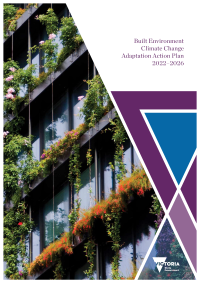The Built Environment Climate Change Adaptation Action Plan is one of 7 plans prepared by the Victorian Government for 7 statewide systems. The plans will help ensure Victoria’s climate resilience, now and into the future.
The challenge
Climate change threatens the built environment – the places we have built to use and enjoy in our everyday lives. This includes physical structures and assets (such as homes, other buildings and infrastructure, including energy infrastructure and systems), built and natural assets (such as cultural heritage places, public parks and sports fields), and how people interact with them via different activities and services.
Across Victoria, our built environment faces potential risks from bushfires, heat, flash flooding and coastal inundation, which can:
- endanger people’s health and safety and increase the incidence of death, injury or disease, such as heat stress during heatwaves and respiratory illness due to bushfires
- disrupt business, services and everyday community activities
- incur major repair costs for buildings and infrastructure
- increase hazard exposure and investment uncertainty, affecting the vitality and growth of our cities, towns, suburbs and regional areas.
Work already underway
- Introducing minimum standards for around 320,000 rented homes' energy efficiency, to improve renters’ comfort and reduce their energy costs.
- Requiring planning schemes to respond to potential coastal impacts and sea level rise.
- Mapping coastal inundation hazards is underway or completed for many coastal areas.
- Providing guidance for development in flood-affected areas.
- Mapping heat vulnerability in Melbourne and preparing advice for cooling our homes and streets.
- Improving planning and building system responses to bushfire risk, for example, by reforming plans to prioritise safety and continuing to direct growth to lower-risk parts of Victoria.
- Building energy infrastructure resilience, from upgrading powerlines to reduce bushfire risks to supporting microgrids, batteries and community renewable energy projects in isolated areas.
Key priorities ahead
The next 5 years (2022–2026) will be focused on improving essential policies and standards to make our built environment more climate-resilient, particularly for highly exposed and vulnerable Victorians.
- Updating building standards to better account for projected impacts such as floods, heatwaves, bushfires and storms.
- Pursuing further upgrades to existing buildings, focusing on improvements such as better insulation and more efficient heating and cooling for low-income and vulnerable Victorians.
- Partnering with social services, government agencies and people who have lived through extreme events to identify support measures for vulnerable and highly exposed communities to adapt.
- Examining options to improve energy infrastructure resilience, including reviewing the adequacy and robustness of existing frameworks to address increasingly frequent and intense storms.
- Continuing to support hazard-exposed communities in developing place-based resilient energy generation, including through temporary relief measures such as generator provision.
- Upskilling and training for community leaders and industry professionals to lead community resilience planning and make homes, commercial buildings and essential services more resilient.
- Supporting highly exposed regional cities and towns to tackle overlapping climate-related events through resilience and recovery planning that considers all hazards.
- Expanding spatial mapping and hazard exposure modelling to improve decisions on land use and infrastructure planning and investment.
Case study: Planting trees for a cooler, greener Melbourne
The Victorian Government is investing $5 million to plant both mature and young trees across Melbourne’s west to help adapt to climate change by providing more shade and green spaces.
Heat extremes during warmer months are made worse in our urban areas due to reduced vegetation cover and the prevalence of hard materials and dark surfaces that absorb heat. This poses significant threats to the health and wellbeing of people, pets and native wildlife. Urban heat is an increasing threat to cities' liveability and productivity, made worse by more frequent and extreme heat days and heatwaves caused by climate change.
Melbourne’s western suburbs experience some of the highest levels of urban heat vulnerability in metropolitan Melbourne. In 2018, Melbourne’s west had just 5.5% canopy cover in urban areas, compared to 17.4% in the inner south-east and 25.9% in the east.
Planting trees to increase shade and cooling through urban forest and canopy cover can reduce air temperatures across a precinct by up to 2°C, helping to reduce heat-related illness and death, and giving people better access to cooler green spaces.
Temperature reductions directly under a canopy tree are greater (around 4°C lower). Tree-planting also benefits biodiversity by introducing varied tree sizes and species and strengthening wildlife corridors. Trees can also help improve air quality by filtering pollutants and support better stormwater management through increased infiltration and reduced runoff.
Further information
| The Built Environment Climate Change Adaptation Action Plan will be delivered over the next 5 years (2022–2026), then updated every 5 years on the path to 2050. Read the full Adaptation Action Plan for the Built Environment system |
Page last updated: 15/02/22
